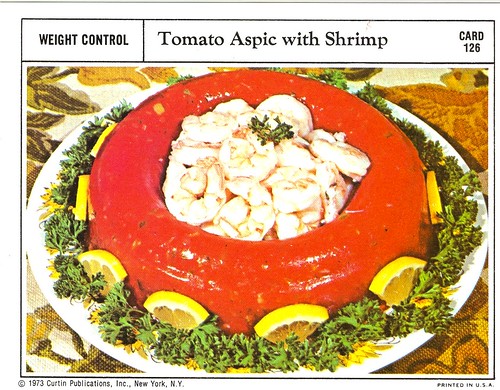Aspic. When was the last time you ate it? Have you ever? Maybe not. It’s not really popular these days.
How about gelatin in general? When was the last time you had gelatin (as a major part of a meal, not just a minor ingredient) that wasn’t some brightly-colored fruity-sweet hue? (Heck, I can’t even remember the last time I ate Jell-O.)
As a child, I had Jell-O a lot. (And I use the brand-name here because brand-name Jell-O was what we ate. Orange. Cherry. Lime. Whatever.) It was always dessert of some sort. Plain, much of the time, or other times with whipped cream on top or as part of some fruit salad mixture at a family or church get-together. (Few things said “1970s church picnic” like a Jell-O fruit salad.)
What I didn’t know at the time was that these gelatin salads were sort of a last vestige of a gelatin salad craze from a few decades earlier.
The 1920s, if the cookbooks can be believed, were gelatin-crazed. Salads, particularly, were not complete without the clear, jiggly stuff. The Silent Hostess Treasure Book from 1930 says, “With a supply of salad greens, a jar of dressing, and some tomato or lemon aspic in your refrigerator you will be able to prepare a great variety of delicious salads on short notice.” To the 21st century cook, only the greens and dressing would be necessary. But the 1920s homemaker would need aspic to be acceptably chic.
The Treasure Book follows the above instruction with recipes for Lemon Aspic and Tomato Aspic. Here’s the lemon:
Lemon Aspic
1 tablespoon gelatin
1/4 cup cold water
1 3/4 cups boiling water
2 tablespoons lemon juice
4 tablespoons vinegar
1/4 teaspoon saltSoak the gelatin in cold water for five minutes and dissolve in boiling water. Add lemon juice, vinegar and salt. Cool. This may be made up ahead, kept in the Cabinet, and used as a basic jelly for vegetable salads.
No sweet lemon Jell-O, that.
An example of how the lemon aspic was then used was Summer Salad:
Summer Salad
Add equal amount chopped cucumber to Lemon Aspic, which has been allowed to thicken slightly. If onion flavor is liked, add one-fourth cup chopped young onions. Turn into molds to chill. Unmold and serve with cooked or mayonnaise dressing.
Ehhh. I can see that it might not taste bad, but I can’t say it sounds good, either. Add some carrots (as the Golden Salad in the same cookbook does), and I suspect you end up with something like this:

…beautiful in a way, and yet also terrifying.
So this leads me to my next ResRec challenge, also from the Silent Hostess book. Tomato Jelly Salad. I mentioned it earlier — it’s on their suggested Thanksgiving menu, so what better time to try it? I am both scared and excited. Will it look like this quite tasty-appearing preparation,

or this meal of doom?

We will find out soon. (And this time I’m making sure Kristen tries it.)
I still need to find some molds and actually buy the gelatin, so it might be a few days before the results are posted. Stay tuned. And enjoy this picture of egg in aspic.

[…] weekend, the time came to make the previously-mentioned Tomato Jelly Salad, a tomato aspic dish that is in the suggested Thanksgiving menu in the Silent […]
I read somewhere that the reason Aspics were so popular is that it was impossible to make them without a refrigerator. Everyone made aspic and gelatin to show off that they were rich and modern enough to own a refrigerator. I don’t remember where I read that, though.
That’s a possibility. There are a lot of aspic recipes in earlier cookbooks, though, from before electric refrigerators were available to households. Maybe it was an ice box, not a fridge, that made the aspic possible.